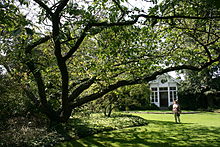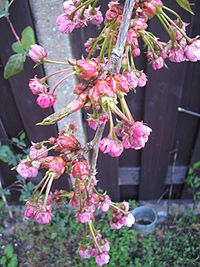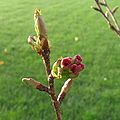- Prunus serrulata
-
For cherry blossoms and their cultural significance to the Japanese, see sakura.
Prunus serrulata Japanese Cherry Prunus serrulata Scientific classification Kingdom: Plantae (unranked): Angiosperms (unranked): Eudicots (unranked): Rosids Order: Rosales Family: Rosaceae Genus: Prunus Subgenus: Cerasus Species: P. serrulata Binomial name Prunus serrulata
Lindl.Synonyms Cerasus serrulata (Lindl.) Loudon
Prunus serrulata or Japanese Cherry; also called Hill Cherry, Oriental Cherry or East Asian Cherry, is a species of cherry native to Japan, Korea and China. It is known for its spring cherry blossom displays and festivals.
Contents
Description
Prunus serrulata is a small deciduous tree with a short single trunk, with a dense crown reaching a height of 8–12 metres (26–39 ft). The smooth bark is chestnut-brown, with prominent horizontal lenticels. The leaves are arranged alternately, simple, ovate-lanceolate, 5–13 cm long and 2.5–6.5 cm broad, with a short petiole and a serrate or doubly serrate margin. At the end of autumn, the green leaves turn yellow, red or crimson.
- Flowers
The flowers are produced in racemose clusters of two to five together at nodes on short spurs in spring at the same time as the new leaves appear; they are white to pink, with five petals in the wild type tree. The fruit is a globose black drupe 8–10 mm diameter.
Cultivation
Prunus serrulata is widely grown as a flowering ornamental tree, both in its native countries and throughout the temperate regions of the world. Numerous cultivars have been selected, many of them with double flowers with the stamens replaced by additional petals.
In cultivation in Europe and North America, it is usually grafted on to Prunus avium 'Wild Cherry' roots; the cultivated forms rarely bear fruit. It is viewed as part of the Japanese custom of Hanami.
The National Cherry Blossom Festival is a spring celebration in Washington, D.C., commemorating the 1912 gift of Prunus serrulata Japanese cherry trees from Tokyo to the city of Washington. They are planted in the Tidal Basin park.
Cultivars and varieties
There are several varieties:
- Prunus serrulata var. serrulata (syn. var. spontanea). Japan, Korea, China.
- Prunus serrulata var. hupehensis (Ingram) Ingram. Central China. Not accepted as distinct by the Flora of China.
- Prunus serrulata var. lannesiana (Carrière) Makino (syn. Cerasus lannesiana Carrière; Prunus lannesiana (Carrière) E. H. Wilson). Japan.
- Prunus serrulata var. pubescens (Makino) Nakai. Korea, northeastern China.
- Prunus serrulata var. spontanea (Maxim.) E. H. Wilson (syn. Prunus jamasakura Siebold ex Koidz.)
Selected important cultivars include:
- Prunus serrulata 'Amonogawa'. Fastigate Cherry, with columnar habit; flowers semi-double, pale pink.
- Prunus serrulata 'Kwanzan'. =P. serrulata 'Sekiyama', 'Kanzan', or 'Kansan'.[1] Kanzan Cherry. Flowers pink, double; young leaves bronze-coloured at first, becoming green.
- Prunus serrulata 'Kiku-shidare'. Cheal's Weeping Cherry. Stems weeping; flowers double, pink. Tends to be short-lived.
- Prunus serrulata 'Shirofugen'. Flowers double, deep pink at first, fading to pale pink.
- Prunus serrulata 'Shirotae'. Mt. Fuji Cherry. Very low, broad crown with nearly horizontal branching; flowers pure white, semi-double.
- Prunus serrulata 'Tai Haku'. Great White Cherry. Flowers single, white, very large (up to 8 cm diameter); young leaves bronze-coloured at first, becoming green.
- Prunus serrulata 'Ukon'.
References
- ^ Arthur Lee Jacobson. "Plant of the Month: April 2005: Japanese Sato zakura in Seattle: Prunus cultivars". http://www.arthurleej.com/p-o-m-April05.html.
- Rushforth, K. (1999). Trees of Britain and Europe. Collins ISBN 0-00-220013-9.
- Flora of China: Cerasus serrulata
- NC State University: Prunus serrulata
- Arborist's photo: size potential for Prunus serrulata 'Shirotae' ('Mt. Fuji')
Gallery
Categories:- Prunus
- Cherry blossom
- Cherries
- Trees of Japan
- Trees of China
- Flora of Asia
- Flora of Japan
- Flora of Korea
- National symbols of Japan
- Garden plants of Asia
- Plants used in bonsai
- Ornamental trees
- Flowers
Wikimedia Foundation. 2010.







